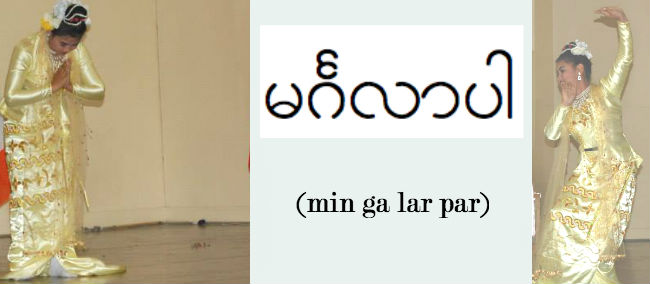![]() (Min ga lar par) You have just learned the general greeting in the Burmese language. However, people who speak this language will more commonly use ,
(Min ga lar par) You have just learned the general greeting in the Burmese language. However, people who speak this language will more commonly use ,![]() ,
, ![]() or
or ![]() . Translated into English all three basically mean “Hello”. The first and second spelling is used in the spoken form of Burmese. The two versions demonstrate two separate “tones” for the same word. The third spelling is used in written Burmese.
. Translated into English all three basically mean “Hello”. The first and second spelling is used in the spoken form of Burmese. The two versions demonstrate two separate “tones” for the same word. The third spelling is used in written Burmese.
The English language, especially in the United States, does not commonly use formal or informal phrases. Many languages globally have formal and informal versions of greetings and other sayings depending on the person you may be speaking with. The Burmese language can be spoken formally or informally. The written form of the language used in official documents and public communications is formal. Therefore, most translations will be written using the formal text.
Nearly Everything is Translated Except…
If you are having a document translated from English into Burmese for use outside of Burma you may find words, numbers, or names that are not translated or have Burmese characters next to the words in parenthesis. Depending on the target audience a translator may keep names of places, addresses, and numbers in the source language and put the pronunciation of the word in parenthesis in Burmese. The reason for doing this may be to help the target audience learn how to pronounce proper names and addresses in the target language, or to help them actually find street names. Just consider, if you’re looking for an address in a foreign country you’re not going to find the street sign in your native language.
Watch your “tone” (no pun intended)
Since we specialize in the Burmese language we would like to tell you nearly everything we know, but if we do, we will surely get lost on our way to “Mandalay”. Here are a few more interesting facts about the Burmese language for your day:
- ၁ (1) Burmese is a tonal language. One word can mean different things depending on a high or low sound. When written these different “tones” are represented by marks above or below a word or phrase.
- ၂ (2) Burmese is written in what is known as “round script”. Many characters appear to have rounded edges. This is because the script was originally written with a palm leaf. Trying to create straight edges would cause the leaf to break.
- ၃ (3) As discussed in the February 25 Blog Post “All Translation is Local”, “Countries are not the same as languages and languages are not the same as countries or ethnic groups”. The Burmese language is spoken in Burma, also known as Myanmar. However the language is not Myanmarese.
- ၄ (4) To make matters even more confusing, the Unicode computer language used is named “Myanmar” and different Unicode versions and keyboards for the language exist. There are also different fonts and styles and not all computers will produce the fonts correctly. If your computer doesn’t have the font installed or a Burmese keyboard installed you many see a translated product look like a bunch of English letters, vlwkdif;bmodxm;&efvdktyfoenf;? or have script with a bunch of boxes in the middle
 . But...more on that in a future edition of “Illegible Stamps and Untranslatables”.
. But...more on that in a future edition of “Illegible Stamps and Untranslatables”.
To learn more about the Burmese language visit this useful links:


Comments
No one has commented on this page yet.
Post your comment